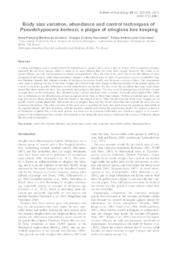Body size variation, abundance and control techniques of Pseudohypocera kerteszi, a plague of stingless bee keeping.
Body size variation, abundance and control techniques of Pseudohypocera kerteszi, a plague of stingless bee keeping.
Author(s): OLIVEIRA, A. P. M. de; VENTURIERI, G. C.; CONTRERA, F. A. L.
Summary: A common technique used to control phorid fly infestations on stingless bee?s nests is the use of traps with commercial vinegars, especially the red wine vinegar, which is stated to be more efficient than the white wine vinegar. However, the claims on its greater efficacy are only circumstantial, not based on experiments. Thus, the aim of this work was to test the efficacy of traps composed of red wine or white wine commercial vinegars on the attractiveness of adult Pseudohypocera kerteszi Enderlein (Diptera Phoridae) females that infested colonies of Melipona fasciculata Smith, and Melipona seminigra Friese. The comparisons were made by placing one trap of red wine vinegar and other of white wine vinegar in infested colonies of the studied species for a week to check for possible differences in their attractiveness on phorids. We also tested the possibility that traps could attract phorid flies from outside the nests, thus potentially increasing an infestation. This was tested by placing traps of red wine vinegar in empty hives in the meliponary, thus eliminating bee?s odours and food stores as factors that could attract phorid flies. There was no difference on the attractiveness of traps composed of red wine or white wine vinegars (Wilcoxon matched-pairs test), and traps did not any attract phorid flies from the outside to the interior of hives. Thus, the red wine and white wine vinegars can be equally used to capture phorid flies that invade nests of stingless bees, and they do not attract flies from outside the nests, thus not increasing infestations. The other objective of this work was to correlate the body size, particularly the maximum head width of the captured phorids and their abundance, with the monthly rainfall levels during the experimental period. We noticed an increase of abundance of phorid flies on the rainy periods, but there was no correlation with body size, which we suggest to be a consequence of the weakening of bee colonies that normally occur during the rainy season, which ease the invasion of them by phorid flies from the environment.
Publication year: 2013
Types of publication: Journal article
Unit: Embrapa Eastern Amazon
Keywords: Abelha-sem-ferrão, Meliponicultura, Praga
Observation
Some of Embrapa's publications are published as ePub files. To read them, use or download one of the following free software options to your computer or mobile device. Android: Google Play Books; IOS: iBooks; Windows and Linux: Calibre.
Access other publications
Access the Agricultural Research Database (BDPA) to consult Embrapa's full library collection and records.
Visit Embrapa Bookstore to purchase books and other publications sold by Embrapa.

